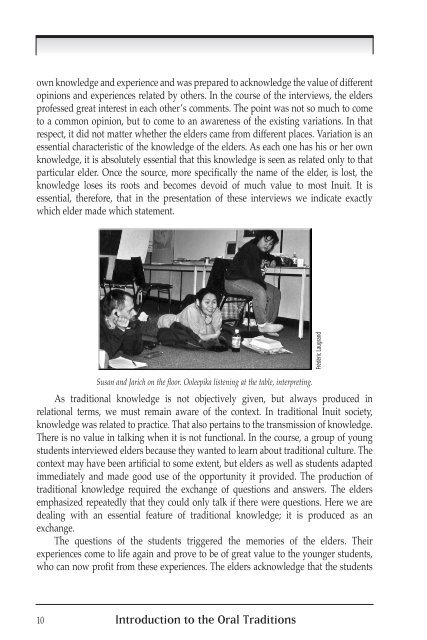Introduction-E
Introduction-E
Introduction-E
Create successful ePaper yourself
Turn your PDF publications into a flip-book with our unique Google optimized e-Paper software.
own knowledge and experience and was prepared to acknowledge the value of different<br />
opinions and experiences related by others. In the course of the interviews, the elders<br />
professed great interest in each other’s comments. The point was not so much to come<br />
to a common opinion, but to come to an awareness of the existing variations. In that<br />
respect, it did not matter whether the elders came from different places. Variation is an<br />
essential characteristic of the knowledge of the elders. As each one has his or her own<br />
knowledge, it is absolutely essential that this knowledge is seen as related only to that<br />
particular elder. Once the source, more specifically the name of the elder, is lost, the<br />
knowledge loses its roots and becomes devoid of much value to most Inuit. It is<br />
essential, therefore, that in the presentation of these interviews we indicate exactly<br />
which elder made which statement.<br />
Frédéric Laugrand<br />
Susan and Jarich on the floor. Ooleepika listening at the table, interpreting.<br />
As traditional knowledge is not objectively given, but always produced in<br />
relational terms, we must remain aware of the context. In traditional Inuit society,<br />
knowledge was related to practice. That also pertains to the transmission of knowledge.<br />
There is no value in talking when it is not functional. In the course, a group of young<br />
students interviewed elders because they wanted to learn about traditional culture. The<br />
context may have been artificial to some extent, but elders as well as students adapted<br />
immediately and made good use of the opportunity it provided. The production of<br />
traditional knowledge required the exchange of questions and answers. The elders<br />
emphasized repeatedly that they could only talk if there were questions. Here we are<br />
dealing with an essential feature of traditional knowledge; it is produced as an<br />
exchange.<br />
The questions of the students triggered the memories of the elders. Their<br />
experiences come to life again and prove to be of great value to the younger students,<br />
who can now profit from these experiences. The elders acknowledge that the students<br />
10 <strong>Introduction</strong> to the Oral Traditions


